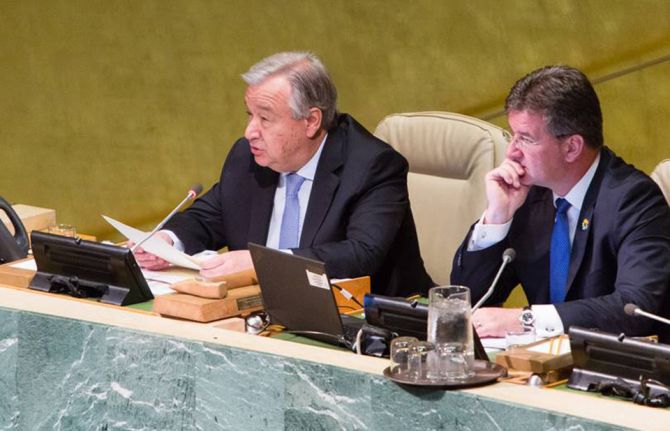

Press Statement
United Nations Member States stress that critical efforts must be scaled up to end AIDS
13 June 2018 13 June 2018United Nations Secretary-General presents his report on HIV as United Nations General Assembly meets to review progress towards ending AIDS
NEW YORK/GENEVA, 13 June 2018—At the halfway point to the 2020 Fast-Track Targets agreed by the United Nations General Assembly in 2016, United Nations Member States have come together to review progress in responding to HIV. Gathered at the United Nations Headquarters in New York, United States of America, Member States presented the progress and challenges in their countries and heard from the United Nations Secretary-General, who presented his report on the global response to HIV.
The President of the General Assembly Miroslav Lajčák opened the meeting. “We cannot forget that what we are doing today ties into our other goals and objectives,” he said. “We can use today’s meeting to explore opportunities for even more action. Let’s keep going. Let’s keep fighting this virus—and the stigma that comes with it.”
The United Nations Secretary-General presented his report, Leveraging the AIDS response for United Nations reform and global health, and said, “The world is making good progress towards ending the AIDS epidemic by 2030, but progress is uneven and fragile. At this pivotal moment, we must renew our focus and shared commitment to a world free of AIDS.”
The report shows that the exponential scale-up of antiretroviral therapy has now reached more than half of all people living with HIV, which in turn has contributed to a decline of one third in AIDS-related deaths, from 1.5 million in 2010 to 1 million in 2016. It also notes the progress in stopping new HIV infections among children and highlights that eliminating mother-to-child transmission of HIV is possible if the world remains focused.
The Executive Director of UNAIDS, Michel Sidibé, attended the plenary meeting. He said, “We are at a critical juncture on the path towards ending AIDS. We must unite and use our collective force to push HIV into permanent decline.”
More than 30 Member States reported on progress in their countries, many expressing their appreciation and support for the work of UNAIDS and the Joint Programme while reiterating their commitment to achieving the targets in the 2016 United Nations Political Declaration on Ending AIDS.
“The United States strongly supports UNAIDS and its leadership in combatting the HIV/AIDS pandemic,” said Deborah Birx, United States Global AIDS Coordinator and Special Representative for Global Health Diplomacy. “UNAIDS’ focus on producing the most extensive data collection on HIV epidemiology continues to be fundamentally important and is our road map to controlling this pandemic. We cannot achieve the targets to end the AIDS epidemic by 2030 without the right data to track our progress, pinpoint our unmet need and effectively and efficiently direct resources for maximum impact.”
The report of the United Nations Secretary-General shows that while the number of people accessing treatment almost tripled from 2010 to June 2017, from 7.7 million people on treatment to 20.9 million, 15.8 million people are still in need of treatment, and progress in expanding access to treatment for children is particularly slow. Just 43% of children living with HIV had access to treatment in 2016.
It also flags that more needs to be done to stop new HIV infections. New HIV infections declined by 18% from 2010 to 2016, from 2.2 million to 1.8 million, but to reach the target of 500 000 new infections by 2020 HIV prevention efforts must be significantly stepped up, particularly among populations at higher risk, a sentiment echoed by many of the speakers at the plenary meeting.
Lazarus O. Amayo, Permanent Representative of Kenya to the United Nations, spoke on behalf of the African Group. “A lot remains to be done as AIDS continues to disproportionately affect sub-Saharan Africa, with the risk of new HIV infections remaining exceptionally high among young women in eastern and southern Africa,” he said. “We reiterate the need for a comprehensive, universal and integrated approach to HIV and AIDS, as well as investments towards it.” In eastern and southern Africa, young women aged between 15 and 24 years account for 26% of new HIV infections, despite making up just 10% of the population.
The report shows there is still much work to do to reach the targets in the 2016 United Nations Political Declaration on Ending AIDS, including filling the US$ 7 billion shortfall in funding for the AIDS response. It sets out five strong recommendations to get countries on track, including mobilizing an HIV testing revolution, safeguarding human rights and promoting gender equality and using the HIV Prevention 2020 Road Map to accelerate reductions in new HIV infections.
In 2016 (*June 2017) an estimated:
- *20.9 million [18.4 million–21.7 million] people were accessing antiretroviral therapy (in June 2017)
- 36.7 million [30.8 million–42.9 million] people globally were living with HIV
- 1.8 million [1.6 million–2.1 million] people became newly infected with HIV
- 1.0 million [830 000–1.2 million] people died from AIDS-related illnesses
UNAIDS
The Joint United Nations Programme on HIV/AIDS (UNAIDS) leads and inspires the world to achieve its shared vision of zero new HIV infections, zero discrimination and zero AIDS-related deaths. UNAIDS unites the efforts of 11 UN organizations—UNHCR, UNICEF, WFP, UNDP, UNFPA, UNODC, UN Women, ILO, UNESCO, WHO and the World Bank—and works closely with global and national partners towards ending the AIDS epidemic by 2030 as part of the Sustainable Development Goals. Learn more at unaids.org and connect with us on Facebook, Twitter, Instagram and YouTube.
